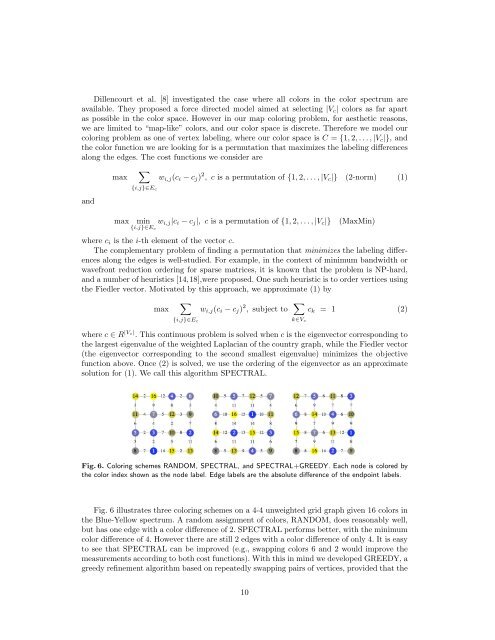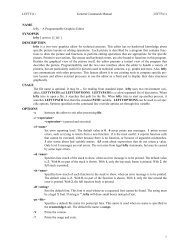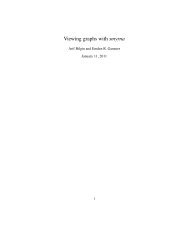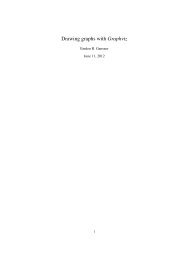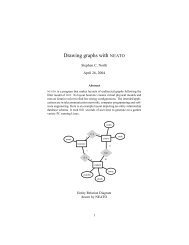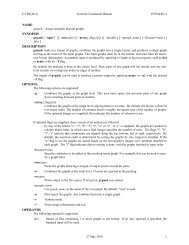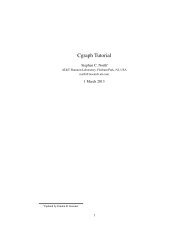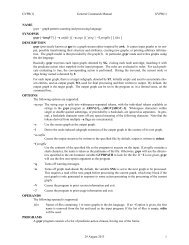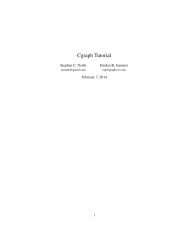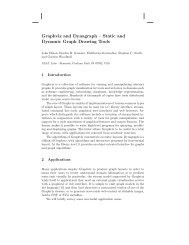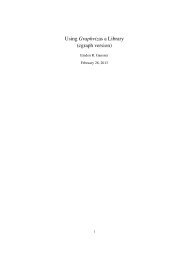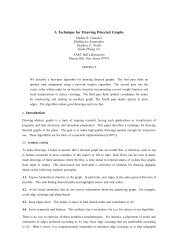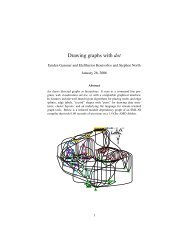Visualizing graphs and clusters as maps - Graphviz
Visualizing graphs and clusters as maps - Graphviz
Visualizing graphs and clusters as maps - Graphviz
Create successful ePaper yourself
Turn your PDF publications into a flip-book with our unique Google optimized e-Paper software.
Dillencourt et al. [8] investigated the c<strong>as</strong>e where all colors in the color spectrum are<br />
available. They proposed a force directed model aimed at selecting |V c | colors <strong>as</strong> far apart<br />
<strong>as</strong> possible in the color space. However in our map coloring problem, for aesthetic re<strong>as</strong>ons,<br />
we are limited to “map-like” colors, <strong>and</strong> our color space is discrete. Therefore we model our<br />
coloring problem <strong>as</strong> one of vertex labeling, where our color space is C = {1, 2, . . . , |V c |}, <strong>and</strong><br />
the color function we are looking for is a permutation that maximizes the labeling differences<br />
along the edges. The cost functions we consider are<br />
<strong>and</strong><br />
max<br />
∑<br />
{i,j}∈E c<br />
w i,j (c i − c j ) 2 ,cis a permutation of {1, 2, . . . , |V c |} (2-norm) (1)<br />
max min w i,j |c i − c j |,cis a permutation of {1, 2, . . . , |V c |}<br />
{i,j}∈E c<br />
(MaxMin)<br />
where c i is the i-th element of the vector c.<br />
The complementary problem of finding a permutation that minimizes the labeling differences<br />
along the edges is well-studied. For example, in the context of minimum b<strong>and</strong>width or<br />
wavefront reduction ordering for sparse matrices, it is known that the problem is NP-hard,<br />
<strong>and</strong> a number of heuristics [14,18],were proposed. One such heuristic is to order vertices using<br />
the Fiedler vector. Motivated by this approach, we approximate (1) by<br />
max<br />
∑<br />
{i,j}∈E c<br />
w i,j (c i − c j ) 2 , subject to ∑ k∈V c<br />
c k = 1 (2)<br />
where c ∈ R |Vc| . This continuous problem is solved when c is the eigenvector corresponding to<br />
the largest eigenvalue of the weighted Laplacian of the country graph, while the Fiedler vector<br />
(the eigenvector corresponding to the second smallest eigenvalue) minimizes the objective<br />
function above. Once (2) is solved, we use the ordering of the eigenvector <strong>as</strong> an approximate<br />
solution for (1). We call this algorithm SPECTRAL.<br />
Fig. 6. Coloring schemes RANDOM, SPECTRAL, <strong>and</strong> SPECTRAL+GREEDY. Each node is colored by<br />
the color index shown <strong>as</strong> the node label. Edge labels are the absolute difference of the endpoint labels.<br />
Fig. 6 illustrates three coloring schemes on a 4-4 unweighted grid graph given 16 colors in<br />
the Blue-Yellow spectrum. A r<strong>and</strong>om <strong>as</strong>signment of colors, RANDOM, does re<strong>as</strong>onably well,<br />
but h<strong>as</strong> one edge with a color difference of 2. SPECTRAL performs better, with the minimum<br />
color difference of 4. However there are still 2 edges with a color difference of only 4. It is e<strong>as</strong>y<br />
to see that SPECTRAL can be improved (e.g., swapping colors 6 <strong>and</strong> 2 would improve the<br />
me<strong>as</strong>urements according to both cost functions). With this in mind we developed GREEDY, a<br />
greedy refinement algorithm b<strong>as</strong>ed on repeatedly swapping pairs of vertices, provided that the<br />
10


